The South Downs Way offers a mesmerizing 100-mile journey through England's scenic landscapes, stretching from Winchester to Eastbourne. This ancient route is adorned with rolling hills, vibrant chalk paths, and sweeping coastal vistas. Highlights include the Seven Sisters Chalk Cliffs with enchanting views of the English Channel, and the Beacon Hill to Amberley section known for its historical charm. Well-marked trails cater to walkers, cyclists, and horse riders alike. Transportation is convenient with train and bus links, while amenities range from quaint inns to campsites. Discover more insights to help plan your adventure along this picturesque national trail.
Key Takeaways
- The South Downs Way is a 100-mile trail from Winchester to Eastbourne with diverse landscapes and coastal views.
- Top trails include the Seven Sisters Chalk Cliffs and Beacon Hill to Amberley for stunning views and historical sites.
- The trail is well-marked with acorn symbols, simplifying navigation for walkers, cyclists, and horse riders.
- Recommended itineraries suggest completing the trail in 6-8 days, averaging 15 miles per day.
- Accommodation options range from cozy pubs to wild camping, with advance booking advised during peak seasons.
Overview of the South Downs Way
How does one capture the essence of the South Downs Way, a distinguished 100-mile trail that elegantly weaves through the heart of England's South Downs National Park?
With its origins dating back to ancient times, this trail is steeped in trail history and cultural significance, serving as an essential artery for travelers, traders, and local communities for centuries.
Originally a series of tracks used by ancient peoples, the path has evolved into a celebrated route that links Winchester in Hampshire to Eastbourne in Sussex, offering a window into England's rich heritage and natural beauty.
The South Downs Way is more than just a trail; it is a journey through time, characterized by its diverse landscapes of rolling hills, chalky paths, and dramatic coastal views, including the iconic Beachy Head and Seven Sisters cliffs.
This charm is only heightened by the trail's accessibility, as it accommodates walkers, cyclists, and horse riders, making it an inclusive experience for all who seek to explore its wonders.
Well-marked with acorn symbols, this historic route invites visitors to immerse themselves in a leisurely adventure, providing a seamless blend of history, culture, and breathtaking scenery.
Top Trails and Routes
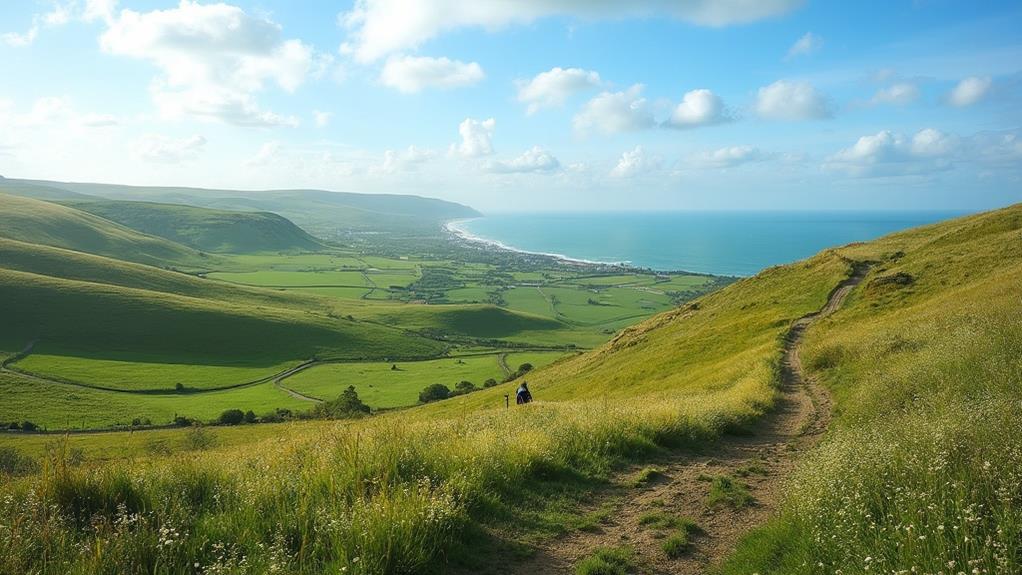
Starting on the South Downs Way offers adventurers an opportunity to explore a tapestry of trails that showcase the remarkable diversity and beauty of England's countryside. Spanning approximately 100 miles from Winchester to Eastbourne, the route traverses rolling hills, chalk streams, and limestone cliffs, each presenting its own unique allure.
Among the hidden gems of this journey, the Seven Sisters chalk cliffs stand out, providing awe-inspiring vistas of the English Channel and the serene Cuckmere Haven.
For those seeking trail challenges, the stretch from Beacon Hill to Amberley is a must. This section is celebrated for its sweeping panoramic views and historical treasures, such as the Bignor Roman Villa. It invites hikers to immerse themselves in rich history while maneuvering its undulating paths.
The South Downs Way is meticulously marked with acorn symbols, ensuring a safe and navigable experience through towns that offer resupply options and accommodation.
Recommended itineraries often suggest completing the trail over 6-8 days, averaging about 15 miles daily. This pace allows hikers to savor the route's stunning natural beauty while balancing the physical demands of the journey, making the South Downs Way an unforgettable adventure.
Transportation and Access
For those planning to commence on the South Downs Way, understanding transportation and access is essential to a seamless hiking experience. The trail is conveniently accessible from London, with direct train services from London Waterloo to Winchester, taking approximately one hour. This ease of access makes the South Downs Way a popular choice for both day trips and extended adventures.
However, effective hiking logistics require awareness of the limited train connections along the route. Nearby stations, such as Amberley and Southease, necessitate supplementary bus or taxi services to reach the trail.
To enhance mobility, consider purchasing a discovery ticket, which offers unlimited bus travel within the South Downs National Park. This option is particularly beneficial for those wishing to explore various segments of the trail without the constraints of linear hiking. Moreover, major train stations like Petersfield and Chichester provide additional access points, facilitating convenient weekend walks.
Planning transportation in advance is vital, especially during peak seasons when accommodation and travel options can become scarce. Coordinating public transport schedules with your hiking itinerary will guarantee a well-organized journey, allowing you to fully enjoy the breathtaking landscapes of the South Downs Way.
Walking and Hiking Tips
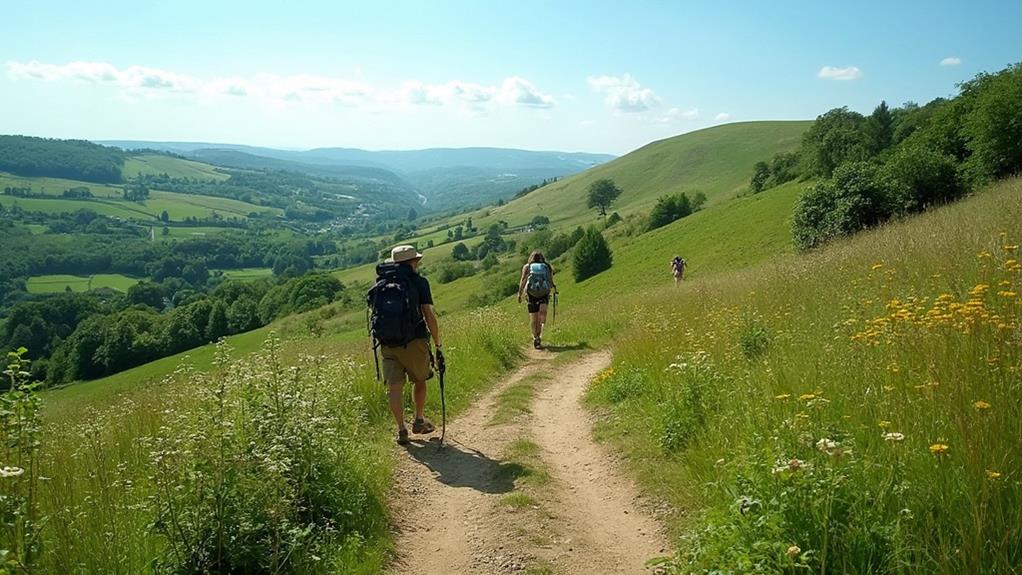
Once transportation logistics are in place, hikers can turn their attention to mastering the art of walking the South Downs Way. This iconic trail stretches approximately 100 miles, offering a rewarding journey through the idyllic landscapes of the South Downs National Park.
To strike a balance between enjoyment and endurance, plan for a 6-7 day hike, averaging 15 miles per day.
Safety precautions are paramount. The trail's difficulty can fluctuate, particularly around the renowned Seven Sisters cliffs, requiring hikers to adjust their daily mileage according to fitness levels and weather conditions.
Navigation is simplified by well-marked paths adorned with acorn symbols and signposts, yet carrying additional navigation tools is advisable to enhance safety.
Gear recommendations are vital for a successful hike. Prioritize waterproof clothing and sturdy footwear to combat unpredictable weather, and aim for a base weight of 15.6 kg excluding food and water.
Planning is essential, particularly for those interested in wild camping. While permitted in designated areas, it's wise to plan campsites in advance for comfort and convenience.
With thoughtful preparation and respect for the environment, the South Downs Way offers an unforgettable hiking experience.
Cycling the South Downs
As we shift from hiking to cycling the South Downs, the extensive network of bridlepaths offers a thrilling experience for cyclists of all skill levels.
These paths not only provide a well-marked and maintained route across the rolling hills and chalky paths of the National Park but also highlight scenic routes that enhance the cycling journey.
Whether you're starting a leisurely ride or seeking a more demanding adventure, the diverse terrain guarantees a memorable exploration tailored to your cycling preferences.
Scenic Cycling Routes
Cycling the South Downs offers an exhilarating blend of natural beauty and cultural richness, making it a prime destination for cycling enthusiasts of all levels. The landscape unfolds through scenic viewpoints that captivate the imagination, from the gentle undulations of rolling hills to the allure of charming villages nestled in picturesque surroundings.
Ensuring cycling safety is paramount, with a thorough cycling adventure guide available to navigate these breathtaking routes. This guide provides detailed information on paths, safety tips, and notable points of interest, enhancing the overall cycling experience.
The South Downs boasts an extensive network of bridlepaths, which are regularly maintained to guarantee a smooth ride. These paths not only cater to mountain biking aficionados but also accommodate those seeking leisurely cycling tours.
The diverse terrain allows for both relaxed and fitness-oriented journeys, engaging cyclists with varying levels of expertise. Convenient transport links from major cities make accessing the South Downs National Park trailheads a breeze, further enriching its appeal as a cycling haven.
Whether it's a short escape or an extended exploration, the South Downs promises an unforgettable cycling adventure that marries natural splendor with cultural depth.
Bridlepath Network Benefits
The extensive bridlepath network of the South Downs stands as a demonstration to its commitment to providing exceptional cycling experiences for enthusiasts of all skill levels. This well-maintained network serves as an idyllic setting for mountain biking, offering a variety of routes that navigate through the undulating landscapes and enthralling chalk cliffs.
Cyclists can enjoy leisurely tours on gentle paths or tackle more challenging trails, all while being guaranteed of cycling safety due to rigorous bridlepath maintenance.
The South Downs bridlepaths are more than just trails; they are gateways to experiencing the region's breathtaking vistas and natural beauty. The paths seamlessly connect key destinations within the South Downs National Park, allowing cyclists to immerse themselves in the serene surroundings.
Regular bridlepath maintenance guarantees that these routes remain accessible and safe throughout the year, providing a reliable platform for cyclists to explore the diverse terrain.
For those seeking a thorough adventure, a cycling guide offers essential information, including route details, safety protocols, and scenic highlights.
This guarantees that cyclists are well-prepared to navigate the South Downs' expansive bridlepath network, making every ride an unforgettable journey through this stunning English landscape.
Skill Level Options
Maneuvering the South Downs bridlepaths offers a versatile cycling experience, perfectly tailored to accommodate riders across a spectrum of skill levels. The extensive network of trails welcomes both novices and seasoned cyclists, each finding their niche within this picturesque landscape.
For beginners, starting on leisurely cycling tours using regular bikes provides a gentle introduction to the varied terrain. Beginner tips emphasize selecting flatter routes, ensuring a smoother ride while indulging in the breathtaking views of rolling hills and charming villages.
For those seeking advanced challenges, the South Downs bridlepaths present an exhilarating opportunity. Mountain biking enthusiasts can tackle rigorous trails, experiencing the thrill of traversing through undulating landscapes and ascending demanding inclines. Detailed adventure guides outline routes and highlight points of interest, empowering cyclists to tailor their journey to their skill level while maximizing the scenic allure.
Accessibility is further enhanced by excellent transport links, enabling cyclists to seamlessly reach trailheads from major cities like London and Portsmouth. Notable sights such as Beachy Head enhance the experience, offering panoramic views that reward every effort exerted on the trails.
Whether seeking serenity or exhilaration, the South Downs cycling paths promise an unforgettable journey.
Horse Riding Trails
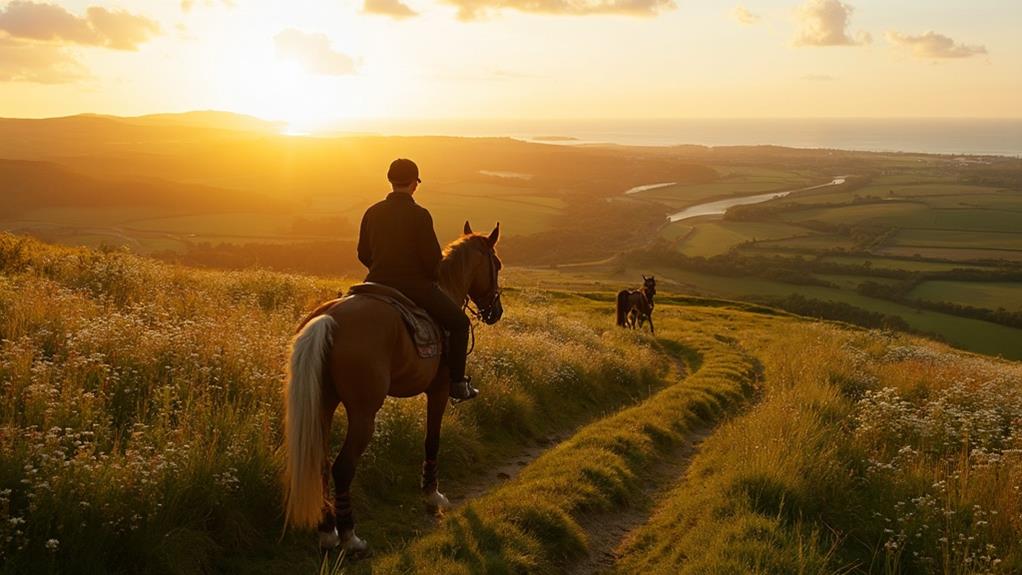
Exploring the South Downs Way on horseback offers an unparalleled experience for equestrians, thanks to its extensive network of well-maintained bridleways.
These trails cater to riders of varying skill levels, providing opportunities for leisurely hacks or invigorating fitness rides. To guarantee a safe and enjoyable adventure, riders should prioritize trail safety by wearing appropriate gear and adhering to equestrian etiquette, such as yielding to pedestrians and cyclists when necessary.
Embracing the panoramic vistas of rolling hills and chalk streams, horse riders can immerse themselves in the natural beauty and historical allure of the South Downs National Park.
Notable sights like Beachy Head and Devil's Dyke serve as breathtaking backdrops, enhancing the riding experience.
A supportive information hub is available, offering resources to enrich one's journey along the South Downs Way.
Riders can also purchase a trail guide to navigate the best routes while exploring the picturesque landscapes.
- Stunning landscapes: Enjoy scenic views of rolling hills and ancient woodlands.
- Trail diversity: Choose from a variety of bridleways suitable for all skill levels.
- Supportive resources: Access thorough guides and advice through the information hub.
- Iconic landmarks: Visit notable sites like Beachy Head and Devil's Dyke.
Accommodation Options
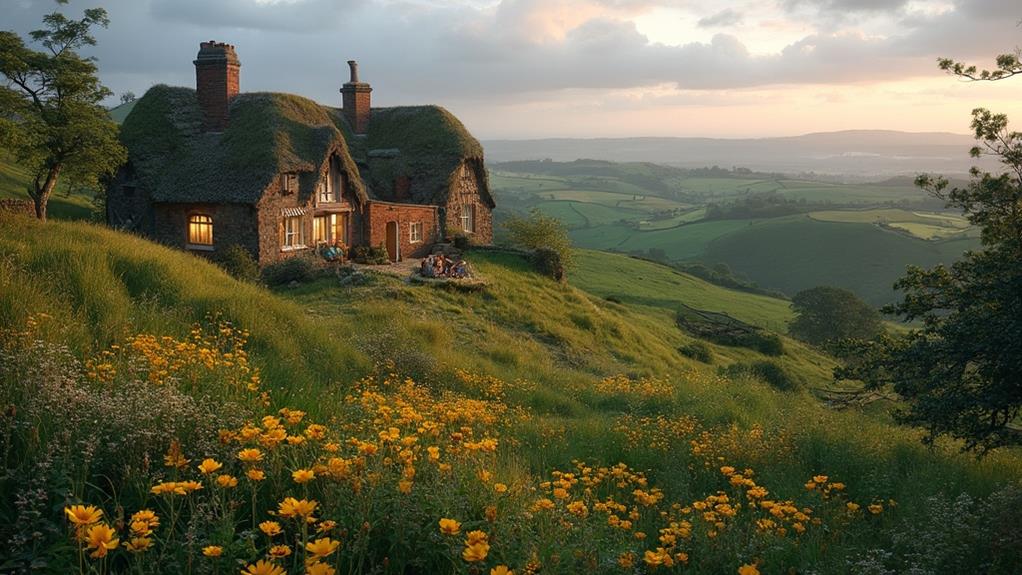
After a rewarding day of horseback riding through the stunning landscapes and iconic landmarks of the South Downs Way, finding the right place to rest becomes an integral part of the journey.
Fortunately, a variety of accommodations cater to different preferences and needs along this picturesque route. Cozy pubs, charming BnBs, and YHA hostels offer inviting accommodation amenities, where travelers can rejuvenate before starting on the next leg of their adventure.
It is advisable to book these accommodations in advance, particularly during peak seasons, to guarantee availability.
For those seeking a more rustic experience, camping is a viable option. However, it's essential to adhere to camping etiquette, especially when wild camping, which is permitted in certain areas.
This requires careful research to avoid trespassing on private lands or farmland, as well as guaranteeing minimal environmental impact. Reviewed campsites like Truleigh Hill, Foxleigh Barn, and Housedean Farm offer comfort and convenience, with fees ranging from £10.00 to £15.00 per night.
Many BnBs enhance convenience by offering free pickups from the trail, adding to the seamless experience.
For detailed planning, the National Trail's Accommodation Guide is an invaluable resource, complete with maps and lodging options.
Planning Your Trip
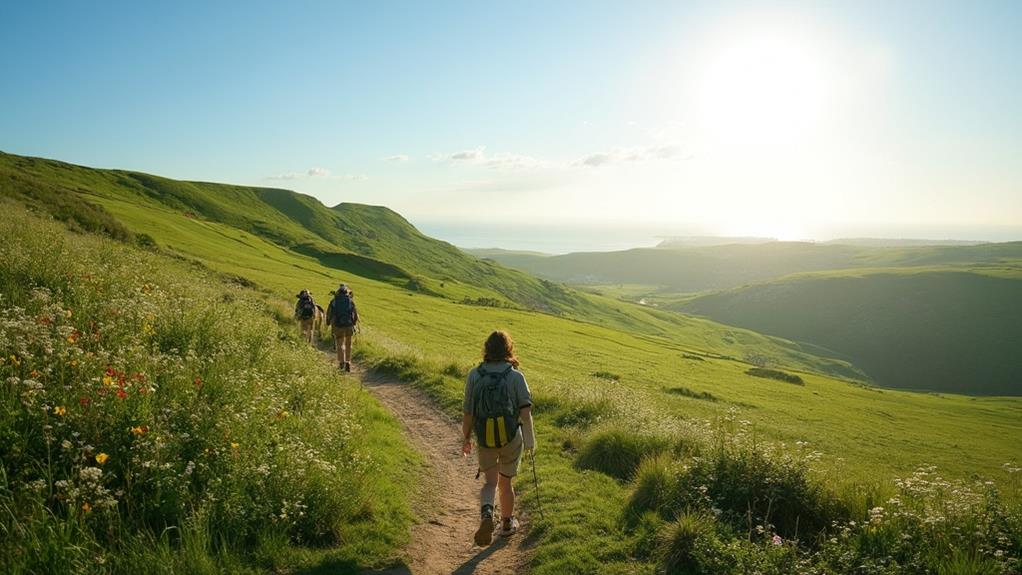
Starting a journey along the South Downs Way requires thoughtful planning to guarantee a seamless experience.
Utilizing route planning tools is essential for mapping out your daily mileage and making sure you remain on track, while accessible transport links from major cities like London facilitate convenient travel to the trail's starting points.
Accommodation options abound, from pre-booked BnBs and campsites to the more adventurous choice of wild camping, each offering unique opportunities to rest and recharge amid the stunning landscapes.
Route Planning Tools
For hikers keen on traversing the South Downs Way, a multitude of route planning tools can greatly enhance the preparation phase.
These tools, designed with route customization and itinerary optimization in mind, allow adventurers to tailor their journey to suit individual preferences and fitness levels. With a recommended hiking duration of 6-7 days, these resources provide valuable daily mileage suggestions to manage time effectively.
Among the most useful tools are thorough guides that simplify trip planning by offering essential insights into transport, accommodation, and activities along the trail.
Additionally, technology plays a pivotal role in modern hiking preparations. Downloadable GPX files and interactive maps offer visual exploration and navigation, enhancing the overall hiking experience. These digital resources guarantee hikers are well-equipped to tackle the diverse landscapes of the South Downs Way.
- Thorough guides: Simplify planning with insights into transport, accommodation, and activities.
- Downloadable GPX files: Facilitate navigation with visual exploration of the trail.
- Interactive maps: Provide an engaging, user-friendly way to visualize routes.
- Daily mileage suggestions: Help optimize itineraries for effective time management.
These tools collectively provide a well-rounded approach to planning a successful journey along the South Downs Way.
Transport and Access
Steering through the picturesque South Downs Way is frequently facilitated by its excellent transport links, ensuring a seamless start to your hiking adventure.
With a direct train journey from London Waterloo to Winchester taking approximately one hour, the trail's accessibility is undeniably convenient for those commencing their journey from the capital. For hikers originating from major cities such as Oxford and Birmingham, split-ticketing offers a cost-efficient rail travel option, making the journey more budget-friendly.
While the main access points are well-connected, several local stations like Amberley and Southease serve as gateways along the trail, albeit requiring additional public transport options such as buses or taxis to reach specific trailheads.
Fortunately, the South Downs National Park offers a discovery ticket, allowing unlimited bus travel within the area, thereby enhancing transportation flexibility and ensuring that even the most remote sections are within reach.
Regular local bus services further facilitate easy access to the South Downs Way, connecting hikers to various trailheads and nearby accommodations.
These reliable public transport systems allow trekkers to immerse themselves in the stunning landscapes of the South Downs Way without concern for logistical challenges, thereby enriching the overall hiking experience.
Accommodation Choices
As you journey along the South Downs Way, the well-connected transport links seamlessly usher you to a domain of diverse accommodation choices, providing comfort and respite after a day of exploration.
Whether you prefer the quaint charm of B&B experiences or the rustic allure of camping under the stars, the trail caters to various preferences and budgets. Cozy B&Bs offer not just a warm bed but also the convenience of free pickups from the trail, enhancing your hiking experience.
Meanwhile, camping enthusiasts can immerse themselves in nature, practicing camping etiquette by pitching late and leaving early to respect local landowners.
- B&B Experiences: Revel in the local hospitality with free pickups and hearty breakfasts.
- Unique Stays: Explore accommodations like yurts for a memorable and distinct experience.
- Camping Sites: Discover dedicated campsites where you can enjoy the tranquility of the outdoors.
- Wild Camping: Embrace the freedom of the open landscape, adhering to responsible camping practices.
Booking in advance, especially during peak seasons, is advisable to secure your preferred choice.
The National Trail's Accommodation Guide is an invaluable resource, offering maps and details about local services, ensuring a seamless and enjoyable journey.
Wildlife and Scenery Highlights
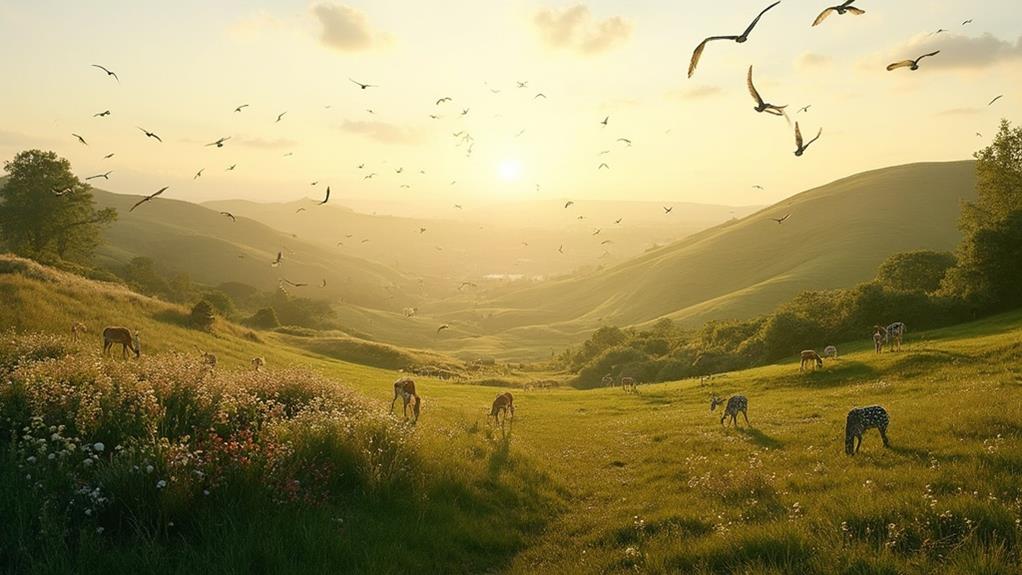
The South Downs Way offers an enchanting tapestry of wildlife and scenery that captivates the senses, showcasing the rich biodiversity and stunning landscapes of the region. This trail is a haven for wildlife spotting enthusiasts, with opportunities to photograph rare species such as red kites, buzzards, and an array of songbirds thriving within the diverse habitats of the South Downs National Park. Scenic photography aficionados will find the rolling chalk hills, ancient woodlands, and scenic chalk rivers particularly compelling, as they provide breathtaking backdrops against which to capture the beauty of the English Channel and the Isle of Wight.
The path meanders through five National Nature Reserves, each offering unique habitats teeming with diverse flora and fauna. Notable viewpoints such as Harting Down and Old Winchester Hill present panoramic vistas, ideal for those seeking to immerse themselves in the tranquil beauty of the countryside and valleys.
| Highlight | Description |
|---|---|
| Seven Sisters Country Park | Iconic chalk cliffs with stunning coastal views |
| Harting Down | Offers panoramic vistas of countryside and valleys |
| Old Winchester Hill | Renowned for its breathtaking views and rich history |
These highlights make the South Downs Way an unforgettable journey into nature's splendor.
Frequently Asked Questions
What Is the Most Scenic Part of the South Downs Way?
The most scenic part of the South Downs Way stretches from Cuckmere Haven to Eastbourne, featuring breathtaking scenic viewpoints like Beachy Head. This area offers stunning landscapes and plentiful wildlife sightings, including red kites and diverse songbirds.
How Many Days to Walk the South Downs Way?
The South Downs Way typically requires 6 to 8 days to traverse, depending on personal pace and preferences. Ideal itineraries highlight daily distances between 12 to 22 miles, ensuring hikers experience both the trail highlights and flexible planning.
How Difficult Is the South Downs Way?
The South Downs Way offers a moderate challenge, with trail conditions being generally well-maintained and accessible. Elevation changes, such as the steep ascent at Seven Sisters, provide some difficulty but are manageable for most hikers.
What Is the Best Map for the South Downs Way?
For ideal trail navigation on the South Downs Way, the Ordnance Survey Explorer Map 122 is the premier choice. This map type offers detailed topographic information and highlights essential landmarks, ensuring a seamless and informative hiking experience.
Conclusion
The South Downs Way offers a remarkable blend of trails that cater to hikers, cyclists, and equestrians, providing a diverse range of experiences across its picturesque landscapes. Accessible transportation options and varied accommodation choices enhance the ease of planning a visit. Rich in both wildlife and scenic vistas, this region invites exploration and appreciation of its natural beauty. Whether traversing its paths on foot, by bike, or on horseback, the South Downs Way promises an unforgettable journey through England's stunning countryside.